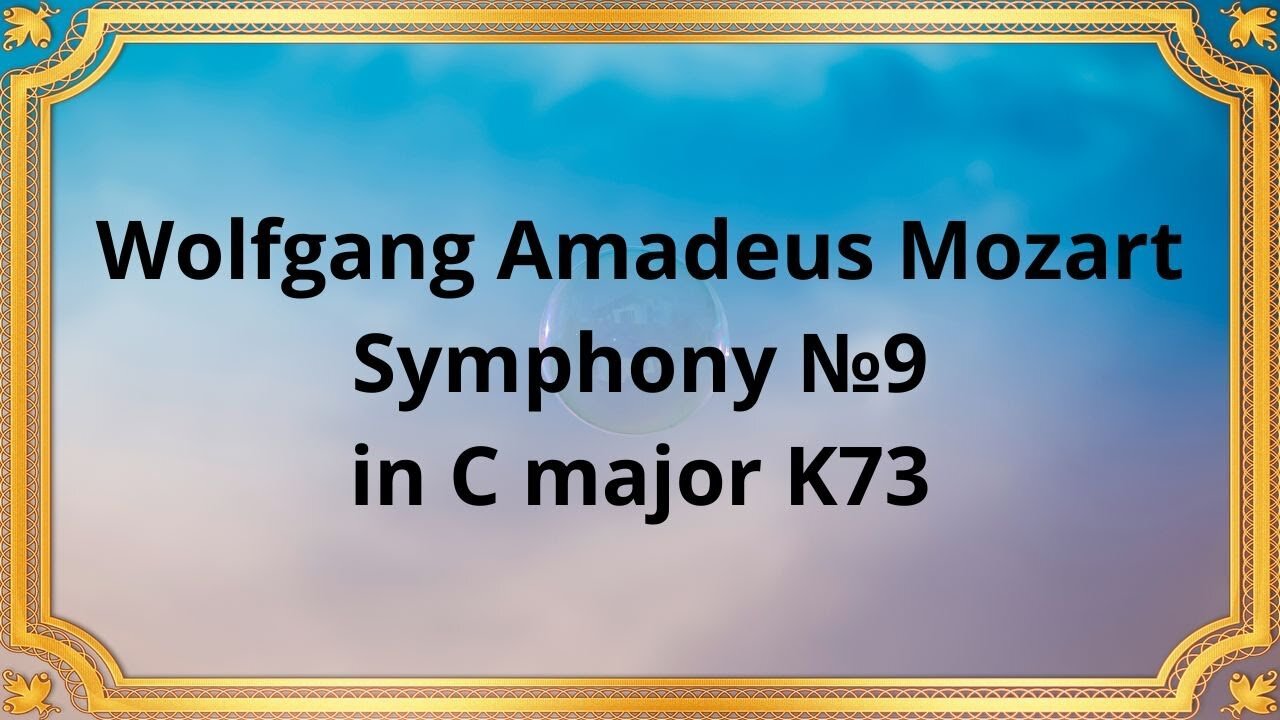Premium Only Content

Wolfgang Amadeus Mozart Symphony №9 in C major 73l
#Mozart#Chamber_music#Classical_music#Symphony#Musical_composition
Wolfgang Amadeus Mozart's Symphony No. 9 in C major, K 73l, is a musical masterpiece that has captivated audiences since its creation in 1770. This symphony is considered one of Mozart's earlier works, and it showcases the young composer's incredible talent and creativity. In this essay, we will explore the history and significance of Symphony No. 9 in C major and delve into its structure, instrumentation, and musical themes.
Symphony No. 9 in C major was composed by Mozart when he was just 14 years old. The work was likely written during his first trip to Italy, where he was exposed to the works of the great Italian composers of the time. The symphony was likely intended to be performed as part of a church service or as part of a musical entertainment in one of the grand salons of the aristocracy.
The symphony was not published during Mozart's lifetime, and it was only discovered in the 19th century, long after the composer's death. However, despite its obscurity, Symphony No. 9 in C major has become a beloved work in the classical music canon, praised for its inventive melodies and expert use of harmony and counterpoint.
Symphony No. 9 in C major is written in the standard four-movement form of classical symphonies. The first movement is marked Allegro, and it begins with a bright, sunny theme in the strings that is quickly taken up by the entire orchestra. The movement is characterized by its energetic rhythms and frequent use of syncopation.
The second movement is marked Andante, and it features a lyrical, expressive melody played by the oboe and then taken up by the strings. The movement is notable for its use of chromaticism, a technique in which the composer uses notes that do not belong to the key of the piece to create tension and interest.
The third movement is marked Menuetto, and it is a lively dance in triple meter. The movement features a playful melody in the strings that is punctuated by the brass and percussion.
The final movement is marked Allegro, and it is a triumphant finale that features a joyous melody played by the strings. The movement builds to a thrilling climax before coming to a jubilant conclusion.
Symphony No. 9 in C major is scored for a standard classical orchestra, which includes two flutes, two oboes, two bassoons, two horns, two trumpets, timpani, and strings.
Symphony No. 9 in C major is known for its inventive and memorable melodies, which are developed and transformed throughout the work. One of the most prominent themes in the first movement is a descending melody played by the violins and cellos. This melody is transformed and developed throughout the movement, creating a sense of unity and coherence.
The second movement features a lyrical melody played by the oboe that is developed and transformed by the strings. The movement is notable for its use of chromaticism, which creates a sense of emotional depth and complexity.
The third movement features a playful melody played by the strings that is punctuated by the brass and percussion. This melody is developed and transformed throughout the movement, creating a sense of variety and interest.
The final movement features a joyous melody played by the strings. This melody is developed and transformed throughout the movement, building to a thrilling climax before coming to a jubilant conclusion.
Conclusion
Wolfgang Amadeus Mozart's Symphony No. 9 in C major, K 73l, is a musical masterpiece that showcases the young composer's incredible talent and creativity. Despite its obscurity during Mozart's lifetime, the symphony has become
-
 34:26
34:26
Classical music_Music Inspiration
1 month agoAram Khachaturian Concerto for Violin and Orchestra
872 -
 27:09
27:09
MYLUNCHBREAK CHANNEL PAGE
1 day agoDilmun: Where Life Never Ends
91.5K56 -
 2:58:32
2:58:32
Slightly Offensive
17 hours ago $94.92 earnedHas Trump FAILED US? The ABSOLUTE STATE of The Right Wing | Guest: Nick Fuentes
136K194 -
 1:37:05
1:37:05
AlaskanBallistics
13 hours ago $3.29 earnedI Love This Gun PodCast #16
47K4 -
 2:59:26
2:59:26
Twins Pod
21 hours agoEMERGENCY PODCAST WITH ANDREW TATE! - Twins Pod - Special Episode - Andrew Tate
202K221 -
 2:52:01
2:52:01
Jewels Jones Live ®
2 days agoTRUMP SECURES BORDER | A Political Rendezvous - Ep. 113
107K38 -
 25:02
25:02
marcushouse
1 day ago $48.26 earnedStarship Just Exploded 💥 What Went Wrong This Time?!
213K133 -
 12:00
12:00
Silver Dragons
1 day agoBullion Dealer Reveals Best Silver to Buy With $1,000
136K12 -
 12:58
12:58
NinjaGamblers
1 day ago $16.51 earnedIs This The BEST Way to Win At Roulette? 😲
166K19 -
 1:01:54
1:01:54
CharLee Simons Presents Do Not Talk
3 days agoCALIFORNIA'S DONE!
115K43